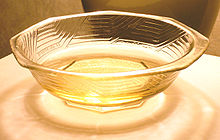Mirin

Mirin(Vị 醂orみりん,Japanese:[miɾiɴ])is a type ofrice wineand a common ingredient inJapanese cooking.It is similar tosakebut with a loweralcoholcontent and higher sugar content.[1]The sugar content is a complex carbohydrate that forms naturally during thefermentationprocess; no sugars are added. The alcohol content is further lowered when the liquid is heated.
Types
[edit]Three types of products are marketed asmirin.The first ishon mirin(literally: true mirin),[2]which contains about 14% alcohol and is produced by a 40 to 60 daymashing(saccharification) process.[3]The second isshio mirin(literally: salt mirin), which contains a minimum of 1.5% salt to prevent consumption in order to avoid alcohol tax.[4]
The third aremirin-like seasonings calledshin mirin(literally: new mirin),[5]ormirin-fu chomiryo(literally: mirin-like seasoning),[6]which are substitutes not actuallymirin.[7]They are blends of sweetenersyrups,flavoringssuch askōjiextracts, andflavour enhancers.[3]They contain less than 1% alcohol.[3]
The term or trade nameaji-mirin(literally: taste mirin) can mean various things, such as salt mirin,[8]synthetic mirin,[6]ormirin-like seasonings.[7]
Uses
[edit]In theEdo period,mirin was consumed asamazake.[9]O-toso,traditionally consumed for the Japanese New Year, can be made by soaking a spice mixture in mirin.[10]
In theKansaistyle of cooking, mirin is briefly boiled before use, allowing some alcohol to evaporate. In theKantōregional style, the mirin is used untreated. Kansai-style boiled mirin is callednikiri mirin(Nấu thiết り vị 醂)[11](literally: thoroughly boiled mirin).

Mirin adds a bright touch to grilled or broiled fish or erases the fishy smell. A small amount is often used instead ofsugarandsoy sauce.It is sometimes used to accompanysushi.
Mirin is also an ingredient in other sauces:
- Kabayaki(grilled eel) sauce: mirin,soy sauce,sake,sugar,fish bone (optional)[12]
- Nikiri mirinsauce: soy sauce,dashi,mirin,sake,in a ratio of 10:2:1:1
- Sushisu(sushi rice vinaigrette): rice wine vinegar, sugar,nikiri mirinsauce
- Teriyakisauce[6]
See also
[edit]- Japanese flavorings
- Mijiu– Chinese rice wine that can be used in cooking
- Huangjiu– Chinese rice wine that can be used in cooking
References
[edit]- ^Shimbo, Hiroko; Shimbo Beitchman (2000).The Japanese Kitchen: 250 Recipes in a Traditional Spirit.Ming Tsai. Harvard Common Press. p. 75.ISBN978-1-55832-177-9.
- ^Yamaguchi, Roy; Joan Namkoong; Maren Caruso (2003).Hawaii Cooks: Flavors from Roy's Pacific Rim Kitchen.Ten Speed Press. p. 19.ISBN978-1-58008-454-3.
- ^abcBổn みりん の tri thức[Abouthon-mirin] (in Japanese). Cả nước vị xối hiệp hội (literally:Japan Mirin Association).Retrieved10 August2013.
- ^"Diversified uses of Mirin".Taiwan News.Archived fromthe originalon 21 December 2008.Retrieved7 January2009.
- ^Telford, Anthony (2003).The Kitchen Hand: A Miscellany of Kitchen Wisdom.Allen & Unwin. p. 153.ISBN9781865088907.
- ^abcShimbo-Beitchman, Hiroko (2000).The Japanese Kitchen: 250 Recipes in a Traditional Spirit.Ming Tsai. Harvard Common Press. p. 77.ISBN978-1-55832-177-9– via archive.org.
- ^abItoh, Makiko (20 May 2014)."Why not add a little booze?".The Japan Times.Archivedfrom the original on 23 May 2014.
- ^"Glossary - Seasonings Mirin (Manjo Mirin, Kotteri Mirin)".Kikkoman.Archivedfrom the original on 5 March 2024.Retrieved29 April2024.
- ^Chiba, Machiko, J. K. Whelehan, Tae Hamamura, Elizabeth Floyd (2005).Japanese Dishes for Wine Lovers.Kodansha International. p. 12.ISBN978-4-7700-3003-0.
{{cite book}}:CS1 maint: multiple names: authors list (link) - ^Gauntner, John (31 December 2001)."An o-tososan a year keeps the doc away".The Japan Times.Archived fromthe originalon 23 July 2009.Retrieved7 January2009.
- ^Tsuji, Shizuo; Mary Sutherland; Ruth Reichl; Yoshiki Tsuji (2007).Japanese Cooking: A Simple Art.Kodansha International. p. 219.ISBN978-4-7700-3049-8.
- ^【 quảng đảo tạp học 】うなぎ の danh cửa hàng に ẩn されたヒミツ bí vân の タレに2 đại mục の ngoài ý muốn な kinh lịch, tích はうなぎ bên ngoài も bán っていた[Hiroshima trivia: The secrets of a renowned eel restaurant].Hiroshima Home Television(in Japanese). 27 November 2021.Archivedfrom the original on 28 November 2021.Retrieved1 June2022.
they fill the pan with about 500 bones of eel, and simmer it for 2 to 3 hours.
